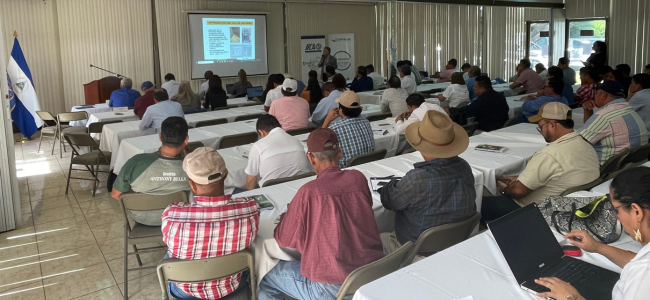To continue improving cattle producers’ knowledge of best practices in animal husbandry and nutrition in Nicaragua, the U.S. Grains Council (USGC), in partnership with the U.S. Department of Agriculture (USDA), U.S. Soybean Export Council (USSEC) and U.S. Livestock Genetics Export recently hosted an animal nutrition and genetics seminar.
“Cooperators, and the USDA/FAS working together brought a variety of products and expertise, which enriched the program. The seminar also benefited from working with the domestic cattle association and IICA, which resulted in a large attendance from both beef and dairy farmers from the diverse regions of the country,” said Alvaro Lopez, USGC regional marketing specialist.
Held at the Instituto Interamericano de Cooperacion para la Agricultura (IICA) in mid-August, the event reached more than 90 people, including representatives from domestic cooperatives and associations, cattle farmers and students.
DDGS optimization in cattle nutrition offered by USGC Consultant Ruben Aguilera was a highlight of the meeting, but the meeting also included topics such as the U.S. export advantage by Lopez; the benefits of raising specific breeds in the region; and selection for heat tolerance genetics, among others.
The Council and its cooperators in the area are dedicated to providing continued trade servicing for producers in the country and throughout the Central American region. By improving the knowledge and technical skills of cattle producers, the Council hopes to not only help increase their productivity, but to also increase the use of feed grains and corn-co products.
“Central America is a region that has seen regular adoption of DDGS in feed diets, and the use of this ingredient continues to grow. In addition to this, Nicaragua’s beef and dairy exports are strong, and feedlot operations are expected to grow. Programs in country will focus on promoting the benefits of both U.S. corn and DDGS, such as their high energy, protein content and other nutritional values to lower feed cost,” Lopez said.
About The U.S. Grains Council
The U.S. Grains Council develops export markets for U.S. barley, corn, sorghum and related products including distiller’s dried grains with solubles (DDGS) and ethanol. With full-time presence in 28 locations, the Council operates programs in more than 50 countries and the European Union. The Council believes exports are vital to global economic development and to U.S. agriculture’s profitability. Detailed information about the Council and its programs is online at www.grains.org.

